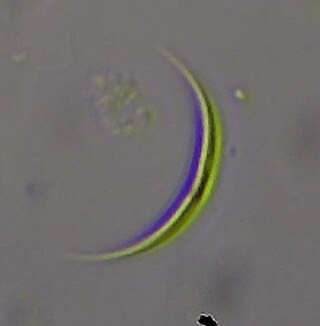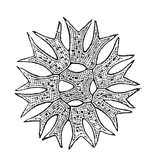
The Chlorophyceae are one of the classes of green algae, distinguished mainly on the basis of ultrastructural morphology. They are usually green due to the dominance of pigments chlorophyll a and chlorophyll b. The chloroplast may be discoid, plate-like, reticulate, cup-shaped, spiral- or ribbon-shaped in different species. Most of the members have one or more storage bodies called pyrenoids located in the chloroplast. Pyrenoids contain protein besides starch. Some green algae may store food in the form of oil droplets. They usually have a cell wall made up of an inner layer of cellulose and outer layer of pectose.

Sphaeropleales is an order of green algae that used to be called Chlorococcales. The order includes some of the most common freshwater planktonic algae such as Scenedesmus and Pediastrum. The Spaeropleales includes vegetatively non-motile unicellular or colonial taxa that have biflagellate zoospores with flagella that are directly opposed in direction : Sphaeroplea, Atractomorpha, Neochloris, Hydrodictyon, and Pediastrum. All of these taxa have basal body core connections.
Neochloridaceae is a family of green algae in the order Sphaeropleales.

Ankistrodesmus is a genus of green algae in the family Selenastraceae. It is one of the most common types of phytoplankton in freshwater habitats around the world.
Ankyra is a genus of green algae in the family Characiaceae. This genus of algae is closely related to Atractomorpha and Sphaeroplea.
Dictyochloris is a genus of green algae in the class Chlorophyceae. It is the sole genus of the family Dictyochloridaceae. It is commonly found in terrestrial and subaerial habitats.
Dictyochloropsis is a genus of unicellular green alga of the phylum Chlorophyta. This genus consists of free-living algae which have a reticulate (net-like) chloroplast that varies slightly in morphology between species, and that when mature always lacks a pyrenoid. Dictyochloropsis is asexual and reproduces using autospores.

Golenkinia is a genus of green algae first described in 1894 by Robert Chodat. The genus is named for the Russian phycologist Mikhail Iljitsch Golenkin. Golenkinia species live in fresh water and are found around the world.

Monactinus is a genus of green algae in the family Hydrodictyaceae. It is very common in freshwater regions throughout the world.

Monoraphidium is a genus of green algae in the family Selenastraceae. Monoraphidium is found free-floating or attached to surfaces in water, or in soils. It is one of the most common types of phytoplankton in freshwater habitats, and has a cosmopolitan distribution.

Parapediastrum is a genus of green algae in the family Hydrodictyaceae. It is fairly common in freshwater regions throughout the world.
Podohedriella is a genus of green algae in the family Selenastraceae. It is found in freshwater habitats or on damp wood.
Pseudomuriella is a genus of green algae, specifically of the class Chlorophyceae. It is the sole genus of the family Pseudomuriellaceae. It is a terrestrial alga that inhabits soils.

Pseudopediastrum is a genus of green algae in the family Hydrodictyaceae. It is very common in freshwater regions throughout the world.
Raphidocelis is a genus of green algae in the family Selenastraceae. They are found in freshwater habitats.
Selenastrum is a genus of green algae in the family Selenastraceae. It is common in freshwater habitats around the world. Most species prefer temperate or warm-temperate waters.

Stauridium is a genus of green algae in the family Hydrodictyaceae. It is very common in freshwater regions throughout the world.

Tetraedron is a genus of green algae in the family Hydrodictyaceae. It may also be spelled as Tetraëdron.
Bracteamorpha is a genus of green algae in the order Sphaeropleales, and is the only genus in the family Bracteamorphaceae. It contains a single species, Bracteamorpha trainorii.
Chlorolobion, sometimes spelled Chlorolobium, is a genus of algae belonging to the family Selenastraceae. The species of this genus are found in freshwater habitats in Europe and America.










